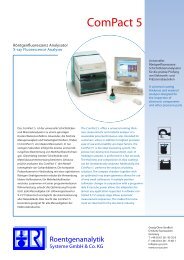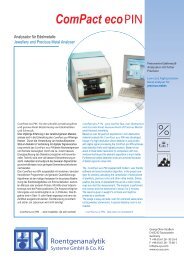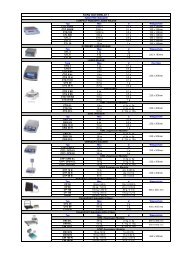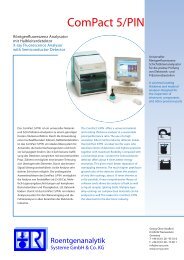Coating Thickness Software for Eagle µ-EDXRF Systems
Coating Thickness Software for Eagle µ-EDXRF Systems
Coating Thickness Software for Eagle µ-EDXRF Systems
Create successful ePaper yourself
Turn your PDF publications into a flip-book with our unique Google optimized e-Paper software.
There are three “default” kV excitation options in FunMaster (20, 30 or 40kV). Where a fast throughput is<br />
required (no time to wait <strong>for</strong> vacuum pump down) and the selected analyte line energies allow, sample<br />
measurements are made in air typically at 30 or 40kV. Where lower energy analyte lines are of interest e.g.<br />
Au(M), Al(K), etc., a vacuum spectrometer environment is necessary and tube voltages of 20kV typically<br />
used. However, other tube kV may be defined (i.e. 15kV), as used <strong>for</strong> the example “Cr on Steel” in this<br />
manual.<br />
NOTE: In practice as far as the influence of the scatter spectra has on subsequent FP calculations,<br />
it is normally sufficient just to collect all scatter spectra data under vacuum and not both air &<br />
vacuum unless, of course, all coating calibrations are to be made in an air filled sample chamber.<br />
The important requirement is that a scatter spectrum contains sufficient statistically-valid data.<br />
Apart from the kV and air/vac conditions, other settings used <strong>for</strong> scatter spectrum collection may differ from<br />
those used <strong>for</strong> the actual calibrations — in particular the Amplifier Time Constant (i.e. the setting that<br />
determines system throughput & energy resolution), tube current and measurement time. For example, at a<br />
40kV (or other) excitation voltage a minimal TC setting (e.g. 2.5µs or 3.2µs DPP) would be used to collect a<br />
scatter spectrum with a tube current setting to attain a maximum DT=30 to 35%. The low TC enables a<br />
higher throughput (i.e. more data collectable in a shorter clock time) because of the lower overall system<br />
dead time (DT) but of course at a poorer energy resolution. The poorer spectral resolution does not<br />
degrade the required in<strong>for</strong>mation contained in a scatter spectrum but would not necessarily be the<br />
conditions used or indeed recommended <strong>for</strong> the actual analysis.<br />
Typical scatter spectra collection conditions should be set as to enable sufficient data (a minimum of 10^6<br />
total counts) to be collected within whatever time is needed - typically at least 1000 seconds. There<strong>for</strong>e at<br />
the required tube kV setting, a tube current sufficient to produce an input CPS that yields a DT of 35% or<br />
less. A typical scatter spectrum, as obtained from a poly-capillary system, is shown in Figure 1.<br />
Figure 1. Wax “scatter/excitation” spectrum <strong>for</strong> a polycapillary lens<br />
system<br />
1.2.1 Collection of Scatter Spectrum 8








